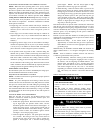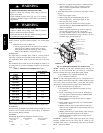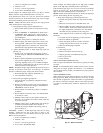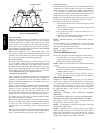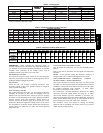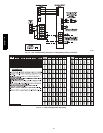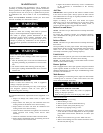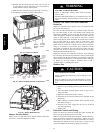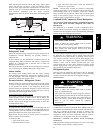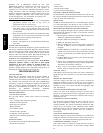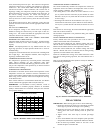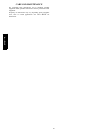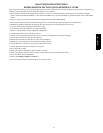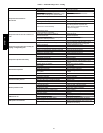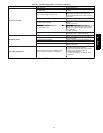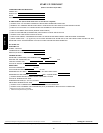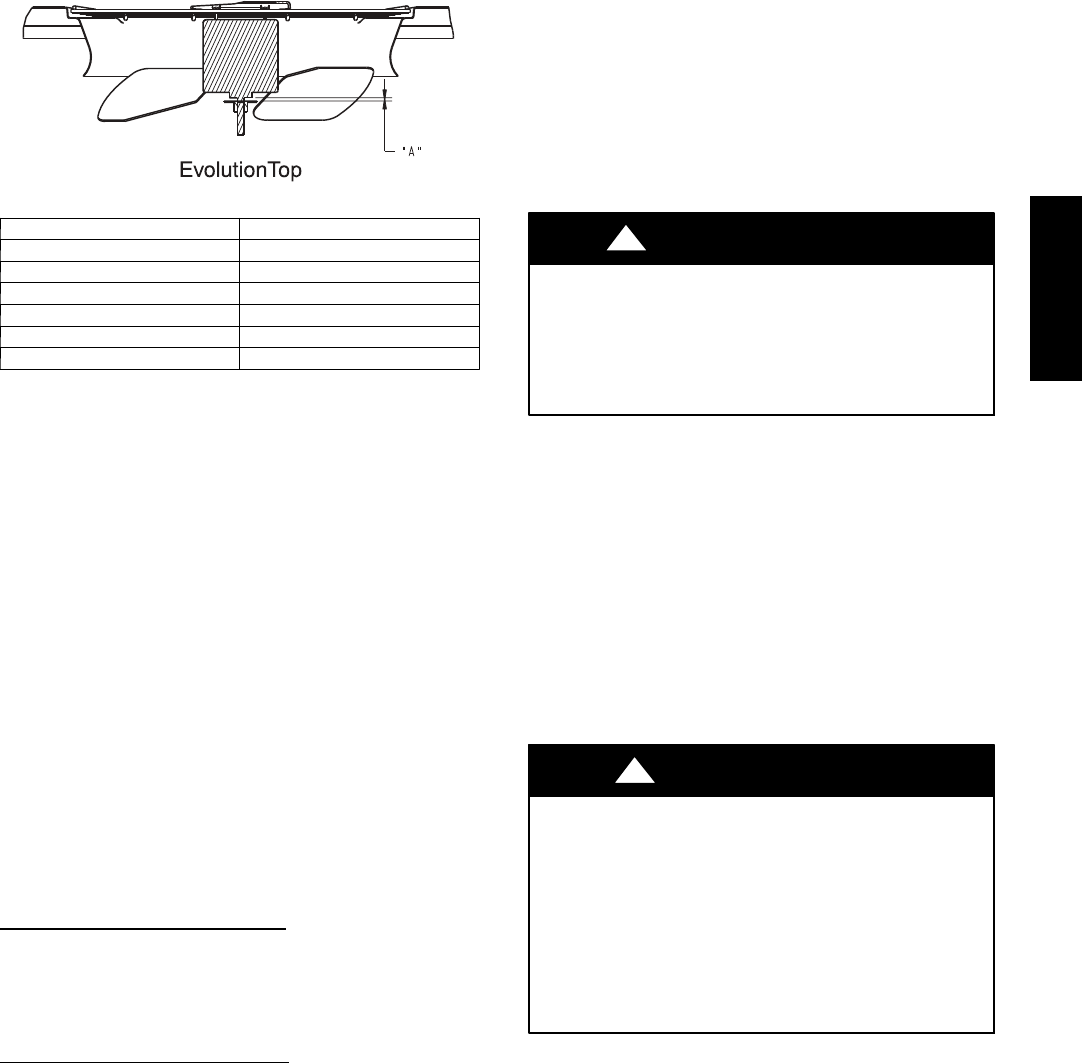
33
After inspecting the electrical controls and wiring, replace all t he
panels. Start the unit, and observe at least one complete cooling
cycle to ensure proper operation. If discrepancies are observed in
ope rating cycle, or if a suspected malfunc tion has occurred, check
each electrical component with the proper electrical
instrumentation. Refer to the unit wiring label when making these
checks.
A06132
UNIT SIZE “A” DIM. IN. (MM)
24 1 (26)
30 1 (26)
36 1 (26)
42 1 (26)
48 11/32 (9)
60 9/16 (14)
Fig. 27 -- Outdoor Fan Blade Clearance
Refrigerant Circuit
Inspect all refrigerant tubing connections and the unit base for oil
accumulation annually. Detecting oil generally indicates a
refrigerant leak.
If oi l is detected or if low performance is suspected, leak test all
refrigerant tubing using an electronic leak detector, or liquid--soap
solution. If a refrigerant leak is detected, refer to Check for
Refrigerant Leaks section.
If no refrigerant leaks are found and low performance is suspected,
refer to Checking and Adjusting Refrigerant Charge section.
Indoor Airflow
The heating and/or cooling airflow does not require checking
unl ess improper performance is suspected. If a pr oblem exists, be
sure that all supply-- and return--air grilles are open and free from
obstructions, and that the air filter is clean.
Pressure Swi tches -- Refrigerant Circ uit
Pressure switches are protective devices integrated into the control
circuit (low voltage). They shut off compressor if abnormally high
or low pressures are present i n the refrigeration circuit. These
pressure switches are specifically designed to operate with Puron
(R--410A) systems. R--22 pressure switches must not be used as
replacements for the Puron (R--410A) system.
Loss--of--Charge (Low Pressure)
Switch
This switch is located on the liquid line and protects against low
suction pressures caused by such events as loss of charge, low
airflow across indoor coil, dirty filters, etc. It opens if the system
pressure drops to about 20 psig. If system pressure is above this,
switch should be closed.
High--Pressure Switches (HPS &
HPS2)
The high--pressure switches are located on the discharge line and
protects against excessive condenser coil pressure. HPS opens at
670 psig shutting down the compressor, while HPS2 opens at 565,
limiting the compressor to low--stage operation only.
High pressure may be caused by a dirty outdoor coil, failed fan
motor, or outdoor air recirculation.
To check switches:
1. Turn off all power to unit.
2. Disconnect leads on switch.
3. Apply ohm meter leads across switch. You should have
continuity on a good switch.
NOTE: Because these switche s are attached to refrigeration
system under pressure, it is not advisable to remove this device for
troubleshooting unless you are reasonably certain that a problem
exists. If switch must be removed, remove and recover all system
charge so that pressure gauges read 0 psi. Never open system
without breaking vacuum with dry nitrogen.
Copeland Scroll Compressor (Puron Refrigerant)
The compressor used in this product is specifically designed to
operate with Puron (R--410A) refrigerant and cannot be
interchanged.
The compressor is an electrical, as well as mechanical, device.
Exercise extreme caution when wor king near compressors. Power
should be shut off, if possible, for most troubleshooting techniques.
Refrigerants present additional safety hazards.
EXPLOSION, FIRE HAZARD
Failure to follow this warning could result in personal
injury or death and/or property damage.
Wear safety glasses and gloves when handling refrigerants.
Keep torches and other ignition sources away from
refrigerants and oils.
!
WARNING
The scroll compressor pumps refrigerant throughout the system by
the interaction of a stationary and an orbiting scroll. The scrol l
compressor has no dynamic suction or discharge valves, and it is
more tolerant of stresses caused by debris, liquid slugging, and
flooded starts. The compressor is equipped with noise reducing
shutdown device and an internal pressure--relief port. The
pressure-- relief port is a safety device, designed to protect against
extreme high pressure. The relief port has an operating range
between 550 and 625 psi differential pressure.
Refrigerant System
This step covers the refrigerant system of the 577D---- A, including
the compressor oil needed, servicing systems on roofs containing
synt hetic materials, the filter drier, and refrigerant charging.
REFRIGERANT
UNIT OPERATION, SAFETY AND
ENVIRONMENTAL HAZARD
Failure to follow this warning could result in personal
injury or equip ment damage.
This system uses Puron (R--410A) refrigerant which has
higher operating pressures than R --22 and other refrigerants.
No other refrigerant may be used in this system. Gauge set,
hoses, and recovery system must be designed to handle
Puron. If you are unsure, consult the equipment
manufacturer.
WARNING
!
COMPRESSOR OIL
If additional oil is needed use Uniqema RL32 --3MAF. If this oil is
not available, use Copeland Ultra 32CC or Mobil Artic EAL22CC.
This oil is extremely hygroscopic, meaning it absorbs water
readily. POE oils can absorb 15 times as much water as other oils
designed for HCFC and CFC refrigerants. Take all necessary
precautions to avoid exposure of the oil to the atmosphere.
SERVICING SYSTEMS ON ROOFS WITH SYNTHETIC
MATERIALS
POE (polyolester) compressor lubricants are known to cause long
term damage to some synt hetic roofing materials.
577D-- -- A



